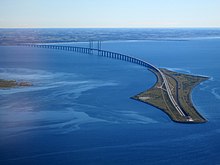Øresund
Øresund or Öresund, also known as "the Sound" in English, is a strait that acts as the border between Denmark's Zealand and Sweden's Scania. It's about 118 kilometers long and varies in width from 4 to 28 kilometers. The narrowest point is 4 kilometers wide, located between Helsingør in Denmark and Helsingborg in Sweden.[1]

Together with the Great Belt, Little Belt, and Kiel Canal, Øresund is one of the four water passages connecting the Baltic Sea to the Atlantic Ocean. This makes it one of the busiest waterways globally. The Øresund Bridge, linking Copenhagen in Denmark to Malmö in Sweden, connects a metropolitan area with nearly 4 million people. Inaugurated in 2000, it's a vital connection. The HH Ferry route, operating between Helsingør, Denmark, and Helsingborg, Sweden, is one of the world's busiest international ferry routes.[2]
Name
changeIn Danish, it's called Øresund, and in Swedish, it's Öresund, informally known as Sundet ("the Sound") in both languages. The name refers to a gravel or sand beach and a sound or strait. The term dates back to around AD 1000, seen on a runestone, and has variations like Eyrarsund in Old West Norse. The name reflects the geography of the area, with "ör" meaning a gravel beach found in many local place names along the strait.[3]
History and Control
changeGeologically, Øresund is a relatively young strait, forming around 8500–8000 years ago due to rising sea levels. It marked a significant shift for the Baltic Sea from a freshwater body connected solely via the Great Belt to becoming a saltwater body.[4]
The control of Øresund has been a crucial part of Danish and Swedish history. Denmark had military control with forts like Kronborg and Kärnan until the eastern shore was handed over to Sweden in 1658. This was based on the Treaty of Roskilde, and both forts are positioned where the strait is 4 kilometers wide.
In 1429, King Eric of Pomerania introduced the Sound Dues, a fee for using the waterways, which lasted over four centuries until 1857. These dues were a significant income source for the Danish Crown, giving kings independence from Denmark's council and aristocracy. To reduce dependence on Øresund, Sweden initiated two major projects: establishing Gothenburg in 1621 and building the Göta Canal from 1810 to 1832.[5]
The Copenhagen Convention of 1857 put an end to the Dues, declaring the Danish straits as international waters. In 2000, the Øresund Bridge provided a fixed connection across the strait, marking a new chapter in its history.[6]
References
change- ↑ Gluver, Henrik; Olsen, Dan (1998-01-01). Ship Collision Analysis: Proceedings of the international symposium on advances in ship collision analysis, Copenhagen, Denmark, 10-13 May 1998. CRC Press. ISBN 978-90-5410-962-4.
- ↑ "Se tidtabell för Scandlines färjor | Scandlines". www.scandlines.se. Retrieved 2023-11-30.
- ↑ Katlev, Jan (2000). Politikens etymologisk ordbog: danske ords historie. Specialordbøger. København: Politikens. ISBN 978-87-567-6200-7.
- ↑ Björck, Svante; Andrén, Thomas; Jensen, Jørn Bo (2008). "An attempt to resolve the partly conflicting data and ideas on the ancylus-Littorina transition". Polish Geological Institute Special Papers. Archived from the original on 15 January 2018. Retrieved 30 November 2023.
{{cite web}}: CS1 maint: multiple names: authors list (link) - ↑ iro.uiowa.edu https://iro.uiowa.edu/esploro/outputs/doctoral/9983777390102771. Retrieved 2023-11-30.
{{cite web}}: Missing or empty|title=(help) - ↑ Law of the Sea Institute (1983). The Law of the Sea in the 1980s. University of Virginia: Law of the Sea Institute. pp. 600–619.